Here’s a recording of a mystery language. Can you guess or do you know which language it is, and where it’s spoken?
Clue this is an Indo-European language.
Here’s a recording of a mystery language. Can you guess or do you know which language it is, and where it’s spoken?
Clue this is an Indo-European language.
Today I found an online version of a BBC television programme called “Cuairt Nam Blog”, in which the presenter, a Scottish Gaelic tutor from Glasgow, meets a number of people who blog in Scottish Gaelic. She find the bloggers through Tìr nam Blòg, a site which amalgamates blogs in Gaelic, and visits the author of An Gaidheal Alascanach in Juneau, Alasaka, and the man behind Latha ann an L.A. in Los Angeles, both of whom speak Gaelic fluently. She also mentions Gaelic bloggers in Kazakstan and Japan. The programme is in Gaelic, with English subtitles.
I read the blogs mentioned in the programme now and then and it’s nice to see the people behind them and learn a bit more about them. I think I should try to write in Gaelic on my other blog, though my Gaelic is not as good as my Irish and Welsh yet. When I write something in Gaelic, I takes me ages as I have to look up many of the words and check the grammar.
The Enduring Voices Project, which I came across today on the National Geographic website, has the aims of documenting endangered languages and preventing language extinction by identifying the most crucial areas where languages are endangered and embarking on expeditions to:
Understand the geographic dimensions of language distribution
Determine how linguistic diversity is linked to biodiversity
Bring wide attention to the issue of language loss
There’s a map on the site which shows the areas of the world with a particular high density of endangered languages, and also provides information about the languages and a few recordings. The ‘hotspots’ on the map are colour coded to give an idea of the severity of the problems. The areas with the most endangered languages are northern Australia, eastern and central Siberia, central South America, and the northwest Pacific plateau of North America.
Here are a few random factoids from the site:
The Yukaghir people (Siberia, 30-150 speakers) traditionally measured time with a unit called ‘the kettle boiled,’ about an hour long. A longer interval was called ‘the frozen kettle boiled,’ which took about 90 minutes.
Tuvan (200,000 speakers) has a word that means ‘the two wives of my two brothers.’ If you had three brothers, or one of your two brothers was unmarried, you would never use this word.
A noun in Tabassaran (95,000 speakers, Dagestan (Russia)) may have up to 53 distinct forms, using suffixes that describe the location and movement of objects in relation to that noun.
Ddes i ‘nôl o Brâg nos Sul ar ôl gŵyl ardderchog. Dinas hardd a diddorol yw Prâg, ac hoffwn i’n mynd ‘nôl cyn bo hir. O Brâg beiciais ar hyd yr afonydd Vltava ac Elbe hyd at Meissen yn yr Almaen gyda ddeuddeg o bobl eraill o Loegr, Cymru, Canada ac Awstralia, ac arweinydd o Wlad Pwyl. Oedd dwy Gymraes-Gymraeg yn y grŵp a sgwrsiais yn Gymraeg gyda nhw.
Beicion tua 30 milltir y dydd – pellter eitha cyffyrddus. Oedd y tywydd yn ddiflas yn ystod hanner cynta’r wythnos – cymylog a gwyntog gyda cryn dipyn o law – ond oedd hi’n braf ar ôl hynny. Arhoson mewn gwestai cyffyrddus gyda gymeriad mewn trefi hanesyddol a deniadol. Oedd y bwyd yn eitha blasus ac oedd digonedd ohonof.
Nos Fawrth, es i’r Hammersmith Irish Centre yn Llundain i gymryd rhan dosbarth mewn canu caneuon o Iwerddon. Meddyliais byddem yn canu ganeuon yn y Wyddeleg, ond y caneuon a ganon ni oedd i gyd yn Saesneg. Dim ots ‘da fi – dw i’n hoffi canu yn unrhyw iaith. Mae hi’n haws cofio geiriau caneuon yn Saesneg hefyd. Mae’r tiwtor yn dda iawn, mae’r pobl eraill yn y dosbarth yn neis, a mwynheais yn dda iawn.
Tháinig mé ar ais ó Phrág oíche Dhomhnaigh i ndiaidh saoire iontach. Is cathair álainn agus suimiúil í Prág, agus ba mhaith liom ag dul ar ais go luath. Ó Phrág rothaigh mé i rith na n-aibhneacha Vltava agus Elbe go Meissen sa Ghearmáin le dáréag daoine eile as Sasana, ón Bhreatain Bheag, as Ceanada agus ón Astráil, agus eolaí ón Pholainn. Ina measc bhí beirt bhan atá Breatnais acu agus rinne mé comhrá Breatnaise leo.
Rothaigh muid thart ar 30 míle gach lá – ní raibh sin ró-fhad, is dóigh liom féin. Bhí an aimsir go dona ar dtús – scamallach agus gaofar le cuid mhaith báisteach – ach bhí sé níos fearr i ndiaidh sin. D’fhán muid in óstáin compordach le caractar i mbailte stairiúil agus tarraingteach. Bhí an bia réasúnta blasta agus bhí go leor ann.
Oíche Mháirt chuaigh mé go dtí an Irish Centre i Hammersmith páirt a ghlacadh i rang ar an amhránaíocht Éireanach. Shíl mé go mbeadh na hamhráin as Gaeilge, ach bhí siad uilig as Béarla. Is cuma liom – is maith liom amhráin a chanadh in aon teanga agus tá sé níos éasca liricí as Béarla a chuimhneamh chomh maith. Tá an teagascóir an mhaith, tá na daoine eile deas, agus bhain mé an-sult as an rang.
The other day I found an interesting interview with Professor Laura-Ann Petitto, a cognitive neuroscientist who has spent the past 29 years seeking to uncover the biological and environmental factors that affect how humans acquire language and how language is organized in the brain. The main aim of her research is the find the biological foundations of language.
She found that the language development of children who grow up bilingually or multilingual is not delayed when compared with monolingual children, as a popular belief suggests. That bilingual and multilingual children do mix languages, just as adults do, and that they do so in a highly principled way. Language mixing is mainly a social phenomenon and the amount of language mixing among children reflects mixing behaviour among adults in their community.
She also studied the optimum time to expose children to two or more languages, comparing groups of children who were exposed to multiply languages at different ages. Some were raised bilingually from birth, others from the ages of three, five, etc. She found that up to nine years old, children immersed in a bilingual environment can become equally fluent in both languages. However if such children are only exposed to one of the languages in school, their ability in that language is much reduced.
Other interesting bits from the interview include the finding that “young children who have rich and early exposure to two languages are […] cognitively more advanced than their monolingual peers on certain highly sophisticated cognitive tasks to do with attention and abstract reasoning.” Also that those children exposed to two languages after the age of nine or so will eventually learn them, but will probably never speak them as well as the early starters.
Here’s a multilingual ingredients list from a packet of dried pineapples I bought while in the Czech Republic. How of the languages on it can you recognise?
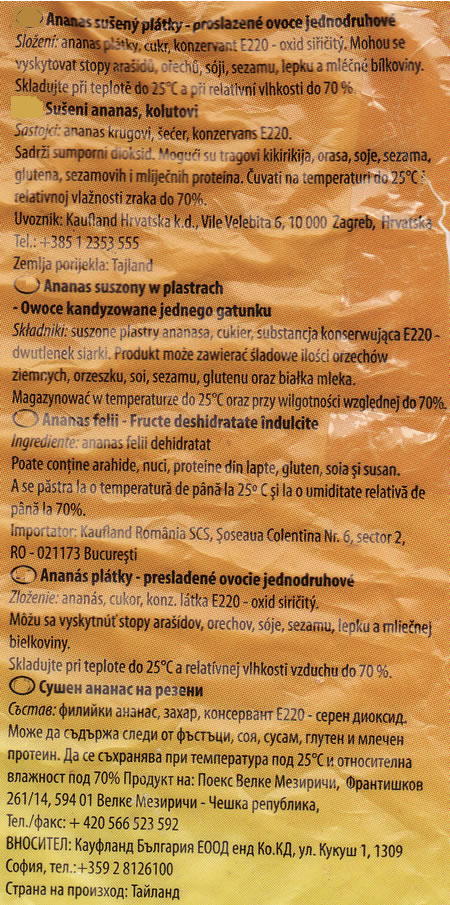
As we haven’t had any language quizzes for a while, I thought it was time for one. Also, I’m off to London this evening for a class in Irish Songs and Singing at the Hammersmith Irish Centre, so don’t really have time to write a longer post. I’ll be going to the class every Tuesday for the next 10 weeks and am really looking forward to it.
I arrived back in Brighton yesterday afternoon after a week in the Czech Republic and Germany, which was great fun.
Prague was stunning and well worth another visit – the day and a bit I had there wasn’t really enough to take it all in. August is apparently a better time to visit, as it tends to get really busy in September and October.
During the first few days of cycling it rained quite a bit and was also quite windy. We also went along some busy roads through areas with a fair amount of heavy industry. Fortunately the weather and scenery improved later on during the week and we had a very enjoyable ride along the Elbe, mainly on well-maintained cycle paths. The towns we passed through or stayed in were attractive and picturesque; the food was plentiful, quite tasty and reasonably priced; and the people we met were generally friendly and welcoming.
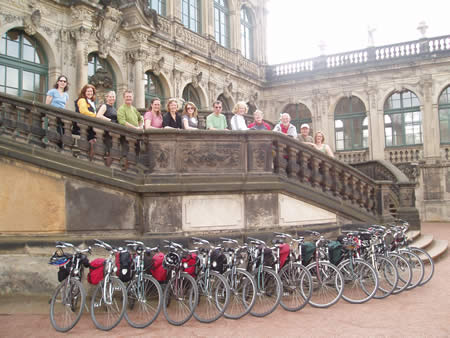
There were 12 others in the group I travelled with, most from the UK, but also a couple of Canadians and an Australian. We ranged in age from 30something to 60something and got on well together. We also had a Polish tour leader, who rode with us, and a Polish driver, who took our luggage from hotel to hotel. Our tour leader spoke good English and a bit of German. He managed to communicate with people in the Czech Republic mainly in Polish with bits of Czech mixed in. The driver spoke Polish and some English, and while he couldn’t understand much Czech, he could understand Slovak quite well.
I used my Czech at every opportunity. Only one Czech person commented on this, asking if I was Czech. Everybody else just talked Czech to me and I did my best to understand them. I also tried out the few Polish phrases I know on our tour leader, and learned a bit more from him. In Germany I tried to speak German to people and found that those who could speak English often did so with me, even if I continued speaking German to them.
I picked up quite a few new Czech words from signs and menus – when you come across them in context every day, they soon sink in. The sight, feel, smell and taste of the food also helps me remember the menu words.
There were two native Welsh speakers in the group and I talked to them a bit in Welsh. They told me that I speak Welsh well with a good accent, and were impressed that my Welsh is self-taught. In 2003 while I was on holiday in northern Portugal, I met some Welsh speakers, but at that time I couldn’t have more than a very limited conversation. Since then I’ve been determined to become fluent in Welsh, and seem to be making good progress.
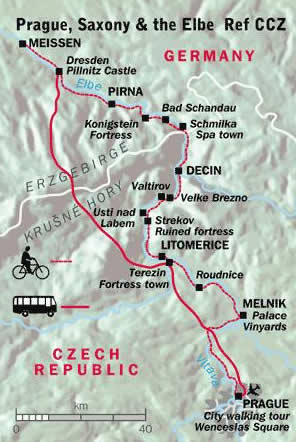
Tomorrow I’m off for week’s holiday in the Czech Republic and Germany with Explore Worldwide. I’ll be flying to Prague early tomorrow morning, then cycling north along the Vltava and Elbe rivers to Meissen in Germany, via Mělník, Litoměřice, Děčín, Pirna, Dresden, and quite a few castles, churches, cathedrals and palaces. After that I’ll go back to Prague by coach, spend a day there, and then return home.
The tour involves five days of actual cycling covering about 30 miles / 45 km a day. Most of the route is along rivers and is apparently flat or downhill, with only occasional uphill sections. So though I haven’t been doing much cycling since I moved to Brighton, apart from some semi-regular unicycling, I’m sure I’ll be able to cope.
I’m also looking forward to having a chance to try out my Czech, and to speaking some German as well.
Yfory dw i’n mynd i’r Weriniaeth Tsiec a’r Almaen am wythnos o wyliau gydag Explore Worldwide. Bydda i’n hedfan i Brag yn gynnar bore fory, ac yna yn beicio i’r gogledd ar hyd yr afonydd Vltava ac Elbe i Meissen yn yr Almaen, trwy Mělník, Litoměřice, Děčín, Pirna, Dresden, a cryn dipyn o gestyll, eglwysi a phalasau. Yna es i yn ôl i Brag ar bws, treulia i dydd fan ‘na, ac wedyn des i adref.
Rothaíocht i mPoblacht na Seice agus an Ghearmáin
Amárach beidh mé ag dul go dtí Poblacht na Seice agus an Ghearmáin ar feadh seachtaine. Déanfaidh mé turas rothaíocht le Explore Worldwide. Beidh an turas ag tosú i mPrág, agus ansin beidh mé ag rothaigh ó thuaidh le taobh na abhann Vltava agus Elbe go Meissen sa Ghearmáin, trí chuid mhaith caisleáin, eaglaisí agus páláis. I ndiaidh sin, rachaidh mé ar ais go Prág ar an mbus, caithfidh mé lá amháin ansin, agus abhaile liom i ndiaidh sin.
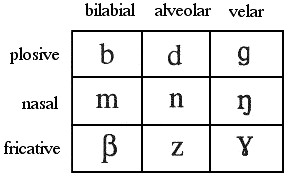
Here’s a game similar to sudoku called LingDoku (illustration top right), which is designed for linguists. According to the Speculative Grammarian, the site where I came across it, “LingDoku simplifies the logical components of SuDoku, and introduces a thin veneer of linguistics which confuses outsiders while making linguists feel superior.”.
The rules of LingDoku are straightforward. Using the nine IPA symbols in the table above, complete the unfinished table below. Each symbol occurs exactly once in the box, and no row or column may contain more than one symbol with either the same place or same manner of articulation. If this one is too easy, there’s a more challenging version called Samurai LingDoku here.
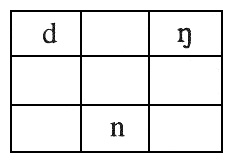
The Speculative Grammarian is well worth a thorough browse, packed as it is with “twisted ramblings, academic parody [and] satirical linguistics”, including The Lingo – A car designed for linguists… by linguists, The European Dialects of Cheese, and crosswords for linguists.